- Joined
- Apr 30, 2005
- Messages
- 34,536
I have a friend who is too shy to post here, so she asked me to post this for her.
To quote her: "I have my grandmother's alexandrite ring, which my mom recently gave me.
It was purchased in Lithuania in the 1920's or 1930's, so I know it's the real deal and not lab created.
I think the stone is 4 or 5 carats, based on what a jeweler thought when he looked at it years ago.
Do you have any idea how I would go about finding a value for it?
At the time I showed it to a local jeweler, he told me that Russian alexandrite was quite valuable.
Now that it's mine, I don't know whether to wear it or to put it in a safe deposit box.
I poked around on Pricescope (didn't sign up or post).
Interesting stuff on alexandrites, including that many thought to be real turn out not to be.
I still think it's worth looking into given what I know about the ring's history.
(Then I told her the gold on the right side is bent away from the gem.)
Wow, Kenny.
Now I'm really glad I posted the pic for you to see.
I didn't notice that damage.
I was focused on the stone rather than the setting.
The stone is not loose at all, and I can't wear it anyway because it's too small for me.
The ring is too small for my mom but she continued to wear it up until a few years ago and it was really hard to get off her finger, and she had to rock it over her finger joint.
I'm guessing that's how it got damaged.
I'm pretty sure its 18K.
If you don't mind posting the pic, that would be great.
I wouldn't have a clue as to who has something of value to say from those who are blowing smoke.
For history...the ring was purchased in Lithuania in the 1920's or early 1930's.
It was sold as alexandrite, which is completely plausible as Lithuania is next door to Russia, where alexandrite is mined.
And of course the stone is named after a Russian tsar.
Twenty years ago I convinced my mom to let me take it to a local jeweler just to look it over.
He used some sort of device to check the refractive index (is that the term?) and it matched that of an alexandrite, though he told me then that a synthetic would also.
He estimated the size at 4 to 5 carats (without removing the stone).
He also said that to make a real assessment I would do best to contact the GIA. I never did anything with it.
Now that my mom has given it to me, I wanted to check into it further in case it valuable. Twenty years ago, the local guy said that genuine alexandrites of good quality were selling for upwards of $8000 per carat.
One thing I read on Pricescope in the discussions on alexandrites is that they change color in sunlight and can look green.
I haven't noticed the stone doing that, but when I took the first pic I did notice the front of it is green in the photo.
I don't know if that's just a fluke or what they're referring to when they say the stone turns green.
Here's the photo, which I'm posting for the green in front in case it means anything to anyone."
End of quote.
So, what do you gals and guys think?
My friend found an appraiser on the PS list, but do you think it would be better for her to send it to AGL?
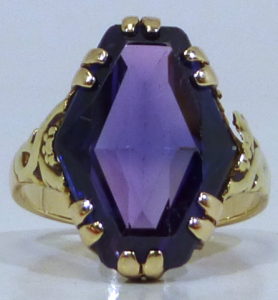
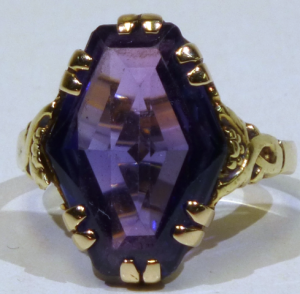
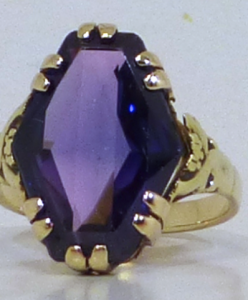
To quote her: "I have my grandmother's alexandrite ring, which my mom recently gave me.
It was purchased in Lithuania in the 1920's or 1930's, so I know it's the real deal and not lab created.
I think the stone is 4 or 5 carats, based on what a jeweler thought when he looked at it years ago.
Do you have any idea how I would go about finding a value for it?
At the time I showed it to a local jeweler, he told me that Russian alexandrite was quite valuable.
Now that it's mine, I don't know whether to wear it or to put it in a safe deposit box.
I poked around on Pricescope (didn't sign up or post).
Interesting stuff on alexandrites, including that many thought to be real turn out not to be.
I still think it's worth looking into given what I know about the ring's history.
(Then I told her the gold on the right side is bent away from the gem.)
Wow, Kenny.
Now I'm really glad I posted the pic for you to see.
I didn't notice that damage.
I was focused on the stone rather than the setting.
The stone is not loose at all, and I can't wear it anyway because it's too small for me.
The ring is too small for my mom but she continued to wear it up until a few years ago and it was really hard to get off her finger, and she had to rock it over her finger joint.
I'm guessing that's how it got damaged.
I'm pretty sure its 18K.
If you don't mind posting the pic, that would be great.
I wouldn't have a clue as to who has something of value to say from those who are blowing smoke.
For history...the ring was purchased in Lithuania in the 1920's or early 1930's.
It was sold as alexandrite, which is completely plausible as Lithuania is next door to Russia, where alexandrite is mined.
And of course the stone is named after a Russian tsar.
Twenty years ago I convinced my mom to let me take it to a local jeweler just to look it over.
He used some sort of device to check the refractive index (is that the term?) and it matched that of an alexandrite, though he told me then that a synthetic would also.
He estimated the size at 4 to 5 carats (without removing the stone).
He also said that to make a real assessment I would do best to contact the GIA. I never did anything with it.
Now that my mom has given it to me, I wanted to check into it further in case it valuable. Twenty years ago, the local guy said that genuine alexandrites of good quality were selling for upwards of $8000 per carat.
One thing I read on Pricescope in the discussions on alexandrites is that they change color in sunlight and can look green.
I haven't noticed the stone doing that, but when I took the first pic I did notice the front of it is green in the photo.
I don't know if that's just a fluke or what they're referring to when they say the stone turns green.
Here's the photo, which I'm posting for the green in front in case it means anything to anyone."
End of quote.
So, what do you gals and guys think?
My friend found an appraiser on the PS list, but do you think it would be better for her to send it to AGL?








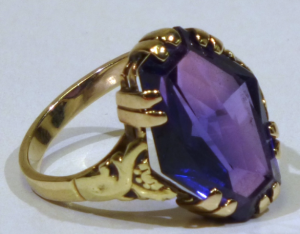
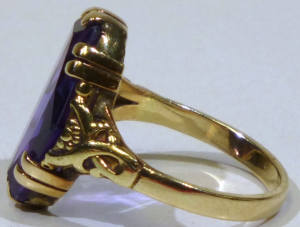
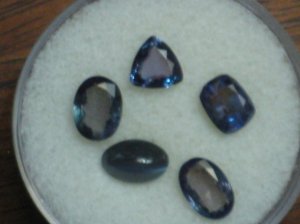
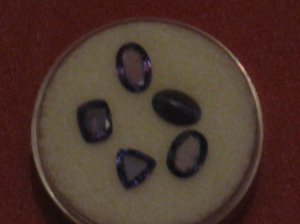


300x240.png)